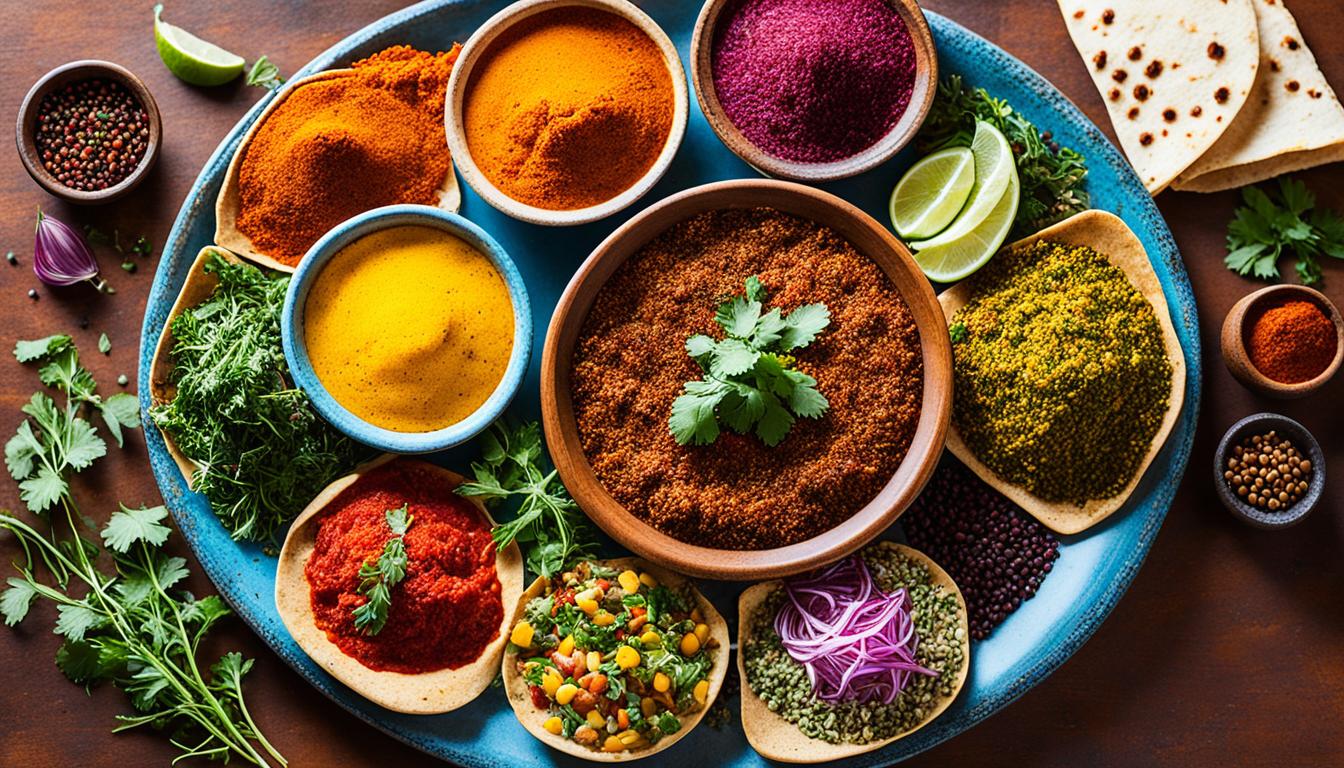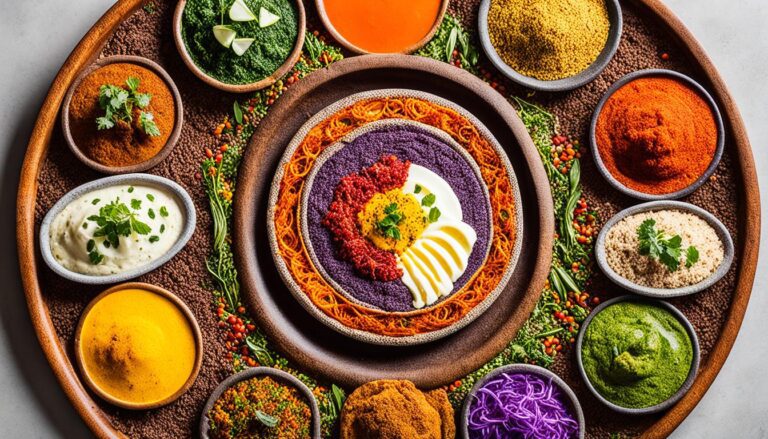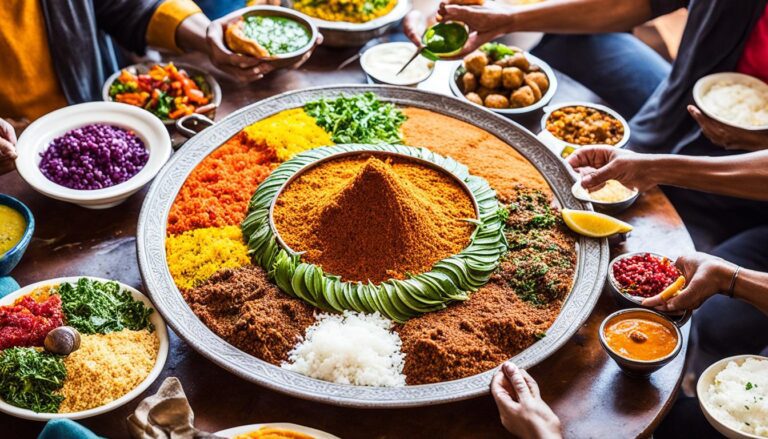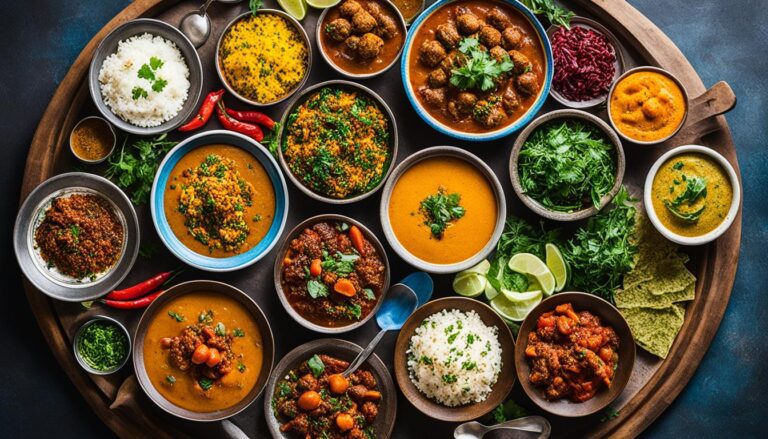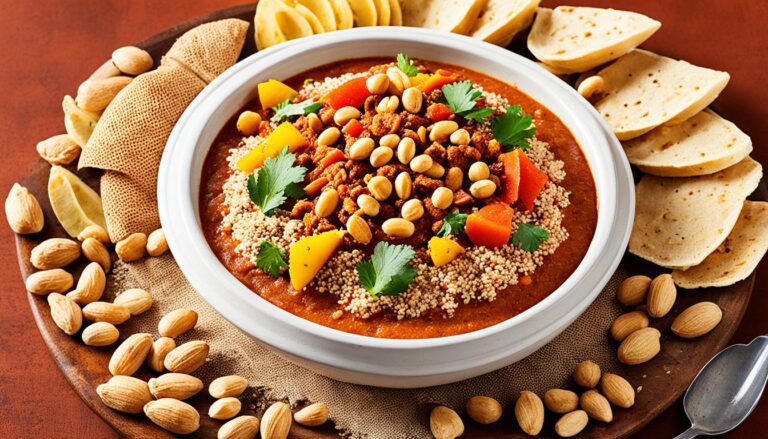Why Is Ethiopian Food So Spicy?
Have you ever wondered why Ethiopian cuisine is known for its fiery and distinct flavors? From the first bite, the explosion of spicy flavors can leave you questioning the origins and secrets behind this vibrant culinary tradition. So, why is Ethiopian food so spicy?
The answer lies in the rich history and cultural influences that shape Ethiopian cuisine. The region’s exposure to exotic spices from India, chile peppers from Portugal, and ginger from East Asian countries has contributed to the bold and intense flavors found in Ethiopian dishes. But it’s not just the introduction of foreign spices that make Ethiopian cuisine spicy; it’s also the indigenous grains, such as sorghum, millet, teff, and wheat, combined with these unique flavors that create a harmonious balance.
At the heart of Ethiopian spice is the famous Berbere seasoning, a traditional blend of chili peppers, fenugreek, cinnamon, ginger, cardamom, and coriander. This aromatic combination adds depth and complexity to the dishes, infusing them with the unmistakable spicy kick that Ethiopian food is renowned for.
As we explore the world of Ethiopian cuisine, we’ll uncover the profile of its flavors, the role of injera, the most popular dishes, the influence of spices, the impact of religious and cultural practices, and even the captivating Ethiopian coffee ceremony. Join us on this spicy culinary journey!
Key Takeaways:
- Ethiopian cuisine is known for its fiery and distinct flavors.
- Exotic spices from India, Portugal, and East Asian countries have influenced Ethiopian cuisine.
- Indigenous grains and the famous Berbere seasoning contribute to the spiciness of Ethiopian food.
- The Ethiopian coffee ceremony is a traditional ritual that complements the spicy flavors of the cuisine.
- Religious and cultural practices have shaped the vegetarian and fasting traditions in Ethiopian cuisine.
The Profile of Ethiopian Food
Ethiopian food is a marriage of various flavors. It combines earthy, spicy, tart, sour, and pungent tastes to create a complex and vibrant dining experience. The use of different spices and ingredients in Ethiopian dishes contributes to this diverse flavor profile.
When you take a bite of Ethiopian food, you embark on a journey of taste sensations. The earthy flavors of indigenous grains such as sorghum, millet, teff, and wheat provide a wholesome foundation for the dishes. These grains are complemented by an array of spices that add layers of complexity and intensity to the flavors.
One of the key characteristics of Ethiopian cuisine is its spiciness. The use of Berbere seasoning, a blend of chili peppers, fenugreek, cinnamon, ginger, cardamom, and coriander, brings a fiery kick to many dishes. These spicy flavors are balanced by tart and sour elements, often achieved through the use of ingredients like lemon juice and tamarind.
In addition to being spicy, Ethiopian food also features pungent flavors that can both surprise and delight the palate. Teff, the grain used to make the traditional Ethiopian bread called injera, has a slightly sour and fermented taste, adding a unique tang to the overall flavor profile. Other pungent ingredients such as garlic, onions, and ginger are commonly used in Ethiopian dishes, further enhancing their boldness.
Let’s not forget about the aromatic and fragrant flavors that permeate Ethiopian cuisine. Spices like cardamom and cinnamon infuse the dishes with warmth, while herbs like basil and thyme add freshness and complexity. These aromatic elements elevate the dining experience and make every bite a sensory delight.
The diverse flavor profile of Ethiopian food makes it a truly unique culinary experience. The combination of earthy, spicy, tart, sour, and pungent flavors creates a symphony of taste that will leave you craving for more.
Ethiopian Food and Injera
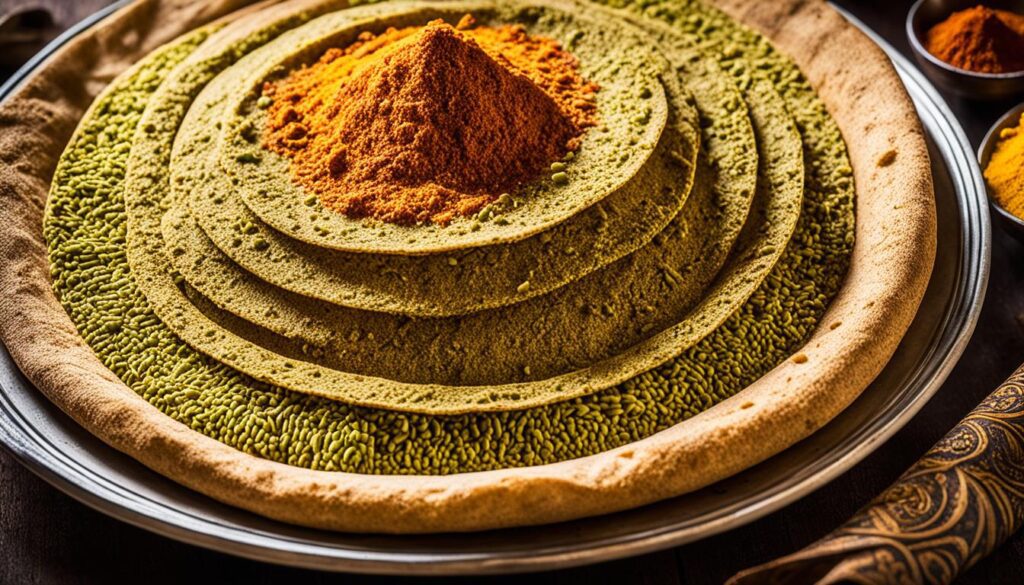
When it comes to traditional Ethiopian cuisine, one cannot overlook the importance of injera. Injera is a sour fermented bread made from teff flour, a tiny grain native to Ethiopia. This versatile bread is not only a staple ingredient in numerous dishes but also plays a significant role in the way Ethiopian food is enjoyed.
One of the unique aspects of Ethiopian dining culture is the tradition of eating with hands. Instead of using utensils, diners rely on injera as a tool to scoop up the delicious flavors of the meal. As a communal food, injera is often placed at the center of the table, with various dishes served on top of it.
To savor the authentic taste of Ethiopian cuisine, we tear off a piece of injera, using it as a vessel to pick up portions of food. By doing so, we experience a delightful combination of textures and flavors as the injera absorbs the juices and spices from the dishes.
This traditional way of eating not only adds to the cultural experience of Ethiopian cuisine but also enhances the sense of connection and togetherness when sharing a meal with family and friends.
Injera truly embodies the essence of Ethiopian food, acting as both a utensil and a key component of the meal. Its unique taste, texture, and role in Ethiopian culture make it an indispensable part of the dining experience.
Exploring the Flavors of Ethiopia
With injera as the foundation of Ethiopian cuisine, let’s delve deeper into the vibrant and diverse flavors that characterize this extraordinary culinary tradition.
Popular Ethiopian Dishes
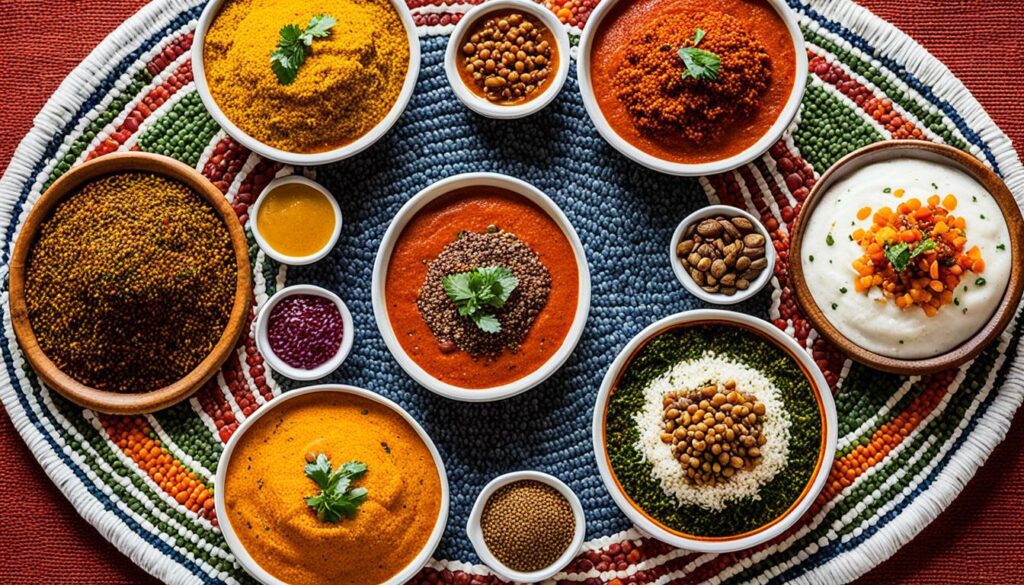
Ethiopia offers a variety of traditional dishes that are well-loved by locals and foreigners alike. When it comes to Ethiopian cuisine, there are three popular dishes that stand out: Tibs, Shiro be Kibbe, and Kitfo.
Tibs
Tibs is a sautéed dish that features tender pieces of beef cooked with onions, garlic, and a flavorful blend of spices, including the famous berbere seasoning. The combination of spices gives Tibs its unique and tantalizing taste. Served with injera, the traditional Ethiopian bread, this dish is a favorite choice for meat lovers.
Shiro be Kibbe
Shiro be Kibbe is a vibrant, red stew made with legumes or lentils. The hearty base is seasoned with a blend of aromatic spices and flavorful herbs, resulting in a rich and savory taste. This dish is often accompanied by injera and is a popular choice among vegetarians and vegans.
Kitfo
Kitfo is a unique and adventurous dish. It consists of finely ground raw beef that is mixed with spiced butter and a touch of chili. The combination of flavors, along with the buttery texture, creates a truly indulgent experience. Kitfo is often served with injera and a side of fresh cheese or vegetables.
These three dishes represent the diverse and flavorful nature of Ethiopian cuisine. Whether you prefer the bold and robust flavors of Tibs, the hearty and comforting taste of Shiro be Kibbe, or the adventurous experience of Kitfo, Ethiopian food offers a culinary journey that is sure to delight your taste buds.
The Influence of Ethiopian Spices
Ethiopian spices play a crucial role in creating the spicy flavors in Ethiopian cuisine. The most prominent spice blend is Berbere, a fiery seasoning that adds depth and complexity to the dishes. Berbere is a blend of chili peppers, fenugreek, cinnamon, ginger, cardamom, and coriander, creating a harmonious fusion of flavors.
When it comes to Ethiopian cuisine, the use of spices is not just about adding heat. It’s about creating a symphony of flavors that awaken the taste buds and ignite the senses. Each spice in the Berbere blend contributes its unique aroma and taste, resulting in a culinary experience like no other.
From the fiery kick of the chili peppers to the warm and aromatic notes of cinnamon and ginger, the combination of these spices adds an unmistakable vibrancy to Ethiopian dishes. It is this blend of spices that gives Ethiopian cuisine its distinct character and allure.
Whether you’re indulging in spicy stews, savory meat dishes, or flavorful vegetarian options, the influence of Ethiopian spices shines through in every bite. They infuse the food with an irresistible depth and complexity, taking your taste buds on a journey of tantalizing flavors.
Religious and Cultural Influences
Ethiopian cuisine is deeply influenced by religious and cultural practices that shape its unique flavors and culinary traditions. Ethiopian Orthodox Christians, Ethiopian Jews, and Ethiopian Muslims all have specific dietary restrictions that greatly impact the cuisine.
Fasting holds significant importance in Ethiopian religious traditions. During fasting periods, adherents abstain from consuming meat and animal products. This spiritual practice has given rise to a diverse and extensive range of delectable vegetarian and vegan dishes in Ethiopian cuisine.
Vegetarianism and fasting are closely intertwined in Ethiopian food culture. This emphasis on plant-based ingredients and the skillful use of spices and flavors has resulted in a remarkable array of vegetarian dishes that are both nutritious and delightfully satisfying.
Vegetarian Delights
One of the most well-known Ethiopian vegetarian dishes is called “Misir Wot,” a spicy lentil stew simmered in berbere sauce. The rich flavors and hearty texture make it a favorite among locals and visitors alike. Another mouthwatering option is “Gomen,” a comforting dish made with collard greens, garlic, ginger, and spices.
The Significance of Fasting
Fasting plays a significant role in Ethiopian culture, not only as a religious observance but also as a means of purification and self-discipline. It is seen as a time of reflection, spiritual healing, and increased awareness of one’s connection to others and the divine. By abstaining from meat during fasting periods, Ethiopian individuals embrace a more plant-based diet that nourishes both body and soul.
Through the practice of fasting and the cultivation of vegetarian dishes, Ethiopian cuisine beautifully showcases how religious and cultural traditions can shape not only the way we eat but also our connection to food, community, and the world around us.
Ethiopian Coffee Ceremony
In addition to its spicy food, Ethiopia is known for its coffee culture. The Ethiopian coffee ceremony is a traditional ritual where coffee beans are roasted, ground, and brewed to create a fragrant and flavorful cup of coffee.
The ceremony begins with the roasting of the fresh coffee beans on a hot pan, filling the room with the irresistible aroma of freshly brewed coffee. The roasted beans are then ground using a traditional mortar and pestle, ensuring the perfect consistency.
Once the coffee is ground, it is transferred to a traditional Ethiopian coffee pot called a jebena. Water is added to the pot, and the coffee is slowly brewed over an open flame, allowing the flavors to develop and intensify.
The fragrant coffee is served in small cups called finjans, often accompanied by traditional snacks such as fresh popcorn or dried grains. The coffee ceremony is a social event, bringing people together to enjoy the rich flavors and engage in conversation.
The traditional Ethiopian coffee is known for its distinct and fragrant flavors. It has a bold and earthy taste, with hints of floral and citrus notes. The experience of the coffee ceremony goes beyond just enjoying a cup of coffee; it is a cultural and sensory journey through Ethiopia’s rich traditions and hospitality.
Conclusion
Ethiopian cuisine is a treasure trove of unique flavors and a vibrant culinary experience. From the spicy kick of berbere seasoning to the earthy and sour notes of injera, Ethiopian food offers a feast for the senses. Whether you’re indulging in the juicy tibs, savoring the rich and saucy shiro be kibbe, or embracing the adventurous flavors of kitfo, every bite brings you closer to the heart of Ethiopian culture and tradition.
The combination of indigenous ingredients and a rich history of spice trading has shaped Ethiopian cuisine into something truly exceptional. Each dish tells a story of the diverse influences that have shaped Ethiopia’s culinary landscape over the centuries. The result is a fusion of flavors that is both comforting and exciting, making every meal an unforgettable experience.
Whether you’re a fan of spicy food or simply looking to expand your palate, Ethiopian cuisine is a must-try. The unique flavors and vibrant ingredients found in this ancient cuisine will transport you to the vibrant streets of Addis Ababa or the lush highlands of Ethiopia. So, gather some friends, order a variety of dishes to share, and embark on a gastronomic adventure that will leave you craving more of Ethiopia’s culinary delights.

